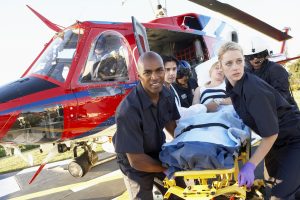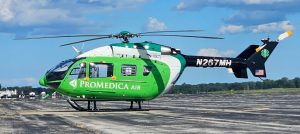Air Medical Transportation
Ever hear an airplane or helicopter flying overhead and wonder where they’re going? Images of tropical locations or big, exciting cities may pop into your mind. Rarely, I would bet, do you consider that the aircraft is for air medical transportation.
What Are Air Medical Services?
The term “Air Medical Services” refers to the use of a plane or helicopter to transport patients and medical personnel safely and efficiently. Known as Air Ambulances, these aircraft function as in-flight medical units, staffed by highly trained professionals such as flight nurses, paramedics, and even physicians in some cases.
Air medical services are frequently utilized for organ transport. This includes transporting a life-saving organ from a donor to a waiting transplant team or flying the transplant recipient to a medical facility to receive the organ. With either scenario, timing is crucial. Utilizing air ambulances is often the only option to meet the critical time window.
When Are Air Medical Services Needed?
In emergency situations, speed and accessibility are vital. Air medical transportation is often necessary in situations where immediate care can make a difference in patient outcomes, including:
- Severe trauma from accidents or falls.
- Cardiac and neurological emergencies, such as heart attacks or strokes.
- Rescue operations in remote or inaccessible locations.
- Disaster response, when traditional routes are blocked or overwhelmed.
Non-Emergency Air Medical Transportation
As odd as it may sound, not all medical air flights are for emergencies. In some cases, they are necessary for transporting a patient who lives in a remote area where specialized medical treatment is unavailable. Or for long-distance medical travel when ground transport is impractical.
Patients unexpectedly hospitalized due to illness or injury in another state or country may also enlist the services of an air medical transport to return them back home.
Types of Aircraft Used
Helicopters are typically called in for emergency situations such as serious car accidents or rescue operations. They are ideal for these circumstances due to their ability to land directly at accident scenes or facilities with helipads, reducing transport times significantly.
In a rescue situation, the terrain surrounding the individual in need is generally impossible for a ground ambulance to successfully navigate. Injuries sustained while hiking, camping, snowmobiling or other outdoor activities in remote areas is a prime example. A helicopter can bring specialist care to the scene and subsequently move the patient to a hospital.
Sometimes, car accidents are so severe that the need for immediate moving of a trauma victim is necessary. A helicopter may be used to facilitate that task, especially when time is critical, and the use of a ground vehicle is not optimal. This may be due to its location or the congestion caused by the accident.
 Fixed-wing Airplanes such as turboprops or jets are ideal for transporting critically ill or injured patients over long distances. They provide more space than a helicopter for medical staff, equipment, and any family members who may accompany the patient.
Fixed-wing Airplanes such as turboprops or jets are ideal for transporting critically ill or injured patients over long distances. They provide more space than a helicopter for medical staff, equipment, and any family members who may accompany the patient.
Medical airplanes contain vital equipment such as stretchers, ventilators, respirators, cardiac monitors, defibrillators and intravenous (IV) pumps. When used for organ procurement missions, the planes have the proper equipment on-board to ensure that the organ remains viable through the trip and well into the transplant process.
While helicopters are best for short-distance, direct hospital transportation, airplanes carry patients and/or medical teams many miles between airports. Ground ambulances then carry the passengers to the designated medical facility.
Coordination and Logistics for Air Medical Transportation
Air medical missions require diligently coordinated efforts and communication between dispatchers, medical facilities, and flight crews. The process begins with a request for service. Trained dispatchers then seek out available aircraft based on patient needs, destination requirements, and availability.
Logistics specialists coordinate with hospitals to confirm landing zones, prepare receiving medical staff, and ensure stability of care upon arrival. Flight crews and medical teams receive real time flight updates, which allows them to prepare necessary equipment and medications even before the patient boards the aircraft.
For long-distance or international trips, additional services such as flight clearances, customs coordination, and arrangements for ground ambulances may be necessary, at both the departing and arriving airports. This careful and precise routine helps to ensure that patients receive seamless, uninterrupted medical attention the entire trip.
Local Example
 Here at KTOL, ProMedica Health System houses and operates the Eurocopter EC135. This twin-engine helicopter features modern technological equipment as well as many superior safety features. It is capable of flying both day and night in most weather conditions and accommodates up to three medical crew members in addition to its pilots and the patient.
Here at KTOL, ProMedica Health System houses and operates the Eurocopter EC135. This twin-engine helicopter features modern technological equipment as well as many superior safety features. It is capable of flying both day and night in most weather conditions and accommodates up to three medical crew members in addition to its pilots and the patient.
Grand Aire is proud to service this fine aircraft when in need of fuel through our 24/7/365 full-service FBO. In addition, we continue to provide transportation options for medical air transport of patients, surgical and transplant teams and human organs for many transplant centers and organ procurement companies.
We are proud to have over 35 years of experience in the air charter industry. Our trained Logistics Specialists promptly evaluate the requirements for each transportation request and quickly provide the most suitable options available.
We are here 24/7/365 to assist with your air transportation needs. Simply call us at 1-800-70-GRAND or email our team directly at logistics@grandaire.com.
